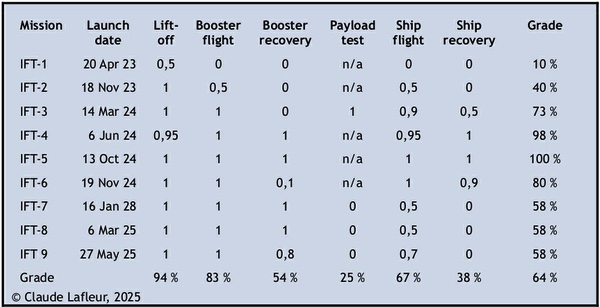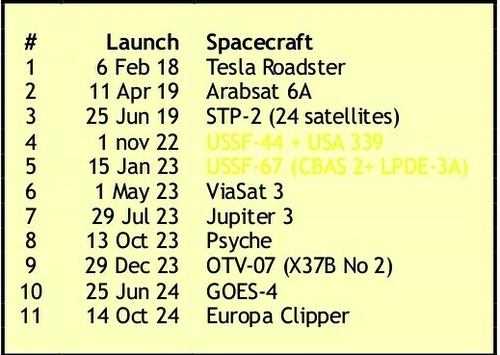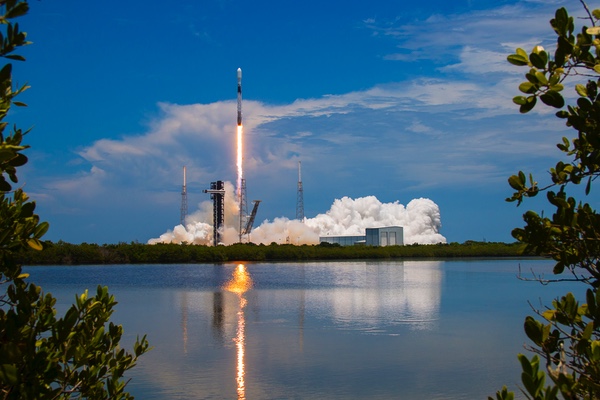What future for SpaceX?Is Elon Musk’s company as promising as it seems?by Claude Lafleur
|
 Table 1: Spacecraft launched, 2016–2025 (as of May 31, 2025) |
 Table 2: Rocket launched, 2016–2025 (as of May 31, 2025) |
Since 2019, SpaceX has been launching the largest constellation of satellites in orbit, with 8,400 Starlink satellites launched to date as part of a communications network that could include up to 34,400 satellites. These 8,400 satellites alone represent more than a third of all spacecraft launched since 1957 (some 22,300 in total).
| It goes without saying that SpaceX arouses as much passion, speculation, dreams as it does doubts. |
Because the Falcon’s first stage is normally recovered after each flight and reused about 20 times, SpaceX is able to offer launches at unbeatable prices. What's more, it organizes group launches, during which dozens of satellites—sometimes more than a hundred—are launched simultaneously. To date, SpaceX has organized 13 Transporter missions and three Bandwagon missions that have lofted more than 1,100 satellites. Such launches allow young companies and organizations with limited resources to access space. In doing so, SpaceX opens space to a host of new users.
Meanwhile, SpaceX is developing the most powerful rocket ever, Starship. In 2022, Elon Musk stated that a single Starship could place as much mass into orbit in a year as anything launched since 1957. “The total mass to orbit to date is around 15,000 to 16,000 tons,” he said on February 10, 2022. “The mass per Starship, just after one year of launching, if it launched three times a day, would be equal to all the mass we’ve orbit today. That’s for one Starship launching three times a day for a year. Now, if you have ten Starships…,” he added.[1]
And of course, Elon Musk dreams of landing a million people on Mars, establishing the first space settlement, claiming SpaceX will soon be ready for such launches.
It goes without saying that SpaceX arouses as much passion, speculation, dreams as it does doubts.
These doubts are largely because we know nothing about the company's financial strength. Are Falcon 9 launches and Starlink operations profitable? Will Starship ever be profitable? And where will the funds required to colonize Mars come from?
SpaceX is principally owned by Elon Musk, although a limited number of investors have the privilege of owning shares in the company. Since SpaceX is not publicly traded, its financial situation is largely unknown. Given the company's remarkable achievements, who wouldn't dream of owning a few shares in SpaceX?
As The Wall Street Journal recently argued: “In the second half of 2024, SpaceX’s valuation grew 67%. Overall, the company’s shares have increased nearly 30-fold between 2015—when SpaceX was valued at $12 billion—and last December, when its valuation hit $350 billion, putting it on par with the likes of Oracle and Coca-Cola.”[2]
“As it has grown to become one of the largest companies in the U.S.”, the article continued, “it has remained one of the most secretive, with its finances hidden from all but a small group of investors and insiders. Most people with stakes in SpaceX have no clue how much money the company makes or loses. Remaining private also allows SpaceX to escape the scrutiny of the stock market.”
But is SpaceX truly profitable and viable in the long term?
While the company's finances remain opaque, analyzing the facts and doing some simple math can help us gain a clearer picture.
Are Falcon 9 operations profitable?
Since 2010, SpaceX has launched nearly 500 Falcon 9 rockets, including 132 last year and more than 50 already this year, with a success rate of over 99%. SpaceX sometimes conducts three launches in less than 24 hours, while most of the rocket's first stages are recovered and reused. This is a performance that no one can match.
To date, SpaceX has conducted about 200 commercial launches, primarily for NASA and the Department of Defense, in addition to more than 250 launches of its Starlink satellites. Of course, there are no figures on the costs and profits generated by these launches. One could hypothesize that profits from commercial launches finance those of Starlink.
However, from 2023, two-thirds of Falcon 9 launches are used to put SpaceX's Starlink satellites into orbit (Table 3).
 Table 3: Starlink Launches by Falcon 9 (as of May 31, 2025). |
It is therefore reasonable to estimate that the profits generated by commercial launches do not cover the cost of Starlink launches. To do so, the profits generated by each commercial launch would have to be twice the launch costs.
Therefore, the Falcon 9 rocket operation, as extraordinary as it is, is undoubtedly unprofitable, given the large number of launches required by Starlink. And everything suggests that this will remain the case as long as Falcon 9s are used to orbit the Starlink fleet.
Is Starlink profitable?
On January 16, 2015, Elon Musk announced a global satellite Internet network which will eventually include some 4,000 satellites in low Earth orbit and an initial service within five years. “The goal will be to have the majority of long-distance Internet traffic go over this network and about 10 percent of local consumer and business traffic,” said Musk.[3]
| This is Starlink’s weakness: the large number of satellites that need to be continually replaced. |
He explained that his company is entering the satellite business in part because there is more money associated with it than with space launch services. “This is intended to be a significant amount of revenue and to help fund a city on Mars,” he said. “Looking at the long term, what’s needed to create a city on Mars? Well, one thing’s for sure—a lot of money. So, we need things that will generate a lot of money.”
By the time SpaceX launched its first batch of Starlink satellites, on May 24, 2019, it was stated that this Internet constellation would ultimately feature 12,000 satellites.[4] It could even reach as much as 34,400 satellites. As of the end of May, more than 8,800 Starlink satellites were launched by more than 250 Falcon 9 rockets.
But that doesn’t mean that two-thirds of the initial 12,000 Starlink network are in place, since, as Jonathan McDowell reports, "the median Starlink operational lifetime [is] 5.3 years."[5] In addition to the satellites that have already completed their useful life, there are those that missed their launch or failed prematurely. Thus, as of January 1, 2025, there were already 735 Starlink out of service.[6]
The fact is that implementing a network of 12,000 satellites is proving to be a colossal undertaking, with SpaceX failing to deliver 2,000 new satellites per year. (In 2022, it launched 1,722 Starlinks, 1,983 in 2023, and 1,981 in 2024.) At SpaceX's current pace, it would take more than six years to orbit its fleet of 12,000 satellites and 17 years for a constellation of 34,400 satellites, not counting those that will reach the end of their life in the meantime and those lost for various reasons.
This is Starlink’s weakness: the large number of satellites that need to be continually replaced. This is the major difference compared to traditional communication satellite networks placed in geostationary orbit. The latter only require a few satellites to serve the entire world and they have a lifespan of 15 to 20 years. A company therefore only has to place a limited number of such satellites and has a decade or more to recoup its investment. Whereas with constellations of thousands of satellites in low orbit, they must be constantly replaced.
But these satellites cost much less than traditional GEO satellites. In the case of Starlink, however, it is not known how much each satellite costs. Fortunately, in May 2024, Quilty Space, a market research and consulting firm, estimates that the latest Starlink V2 mini version carries a price tag of $800,000. They project that future individual V3s will cost roughly $1.2 million.[7]
This means that the total cost of the 2,000 satellites launched each year is around $2 billion, not including launch costs. Added to these costs are the operation of a fleet of thousands of Starlinks and other operating costs, as well as the distribution and service of hundreds of thousands of ground terminals and other hardware. How much does it cost to keep a fleet of thousands of satellites operational?
And how much do Starlink services bring in?
According to another forecast released in December 2024 by Quilty Space, “Starlink is projected to reach $11.8 billion in revenue next year. This represents a substantial increase from the estimated $7.7 billion in revenue for 2024. The 2025 revenue projection includes $7.5 billion from consumer services, $1.3 billion in hardware sales, and $3 billion from U.S. government contracts.”[8]
These are big numbers, big projections. However, if we project a constellation of 34,400 satellites that must be replaced every 5.3 years, SpaceX will have to triple or even quadruple its current launch rate, and therefore launch between 6,000 and 8,000 satellites per year. Assuming that each satellite costs $1.2 million plus, say, $800,000 to launch each one,[9] we can argue that it will cost $12 to $16 billion just to maintain the Starlink fleet, plus all other operating costs, year after year after year.
So one might wonder whether the Starlink network will be a major source of funding for Elon Musk's Martian ambitions, or rather a bottomless financial pit?
There will be a Starship
On September 29, 2016, Elon Musk announced the development of a large new launch vehicle and a reusable spacecraft that could be ready to take 100 people to Mars as soon as the mid-2020s. This “Interplanetary Transport System,” he said, will uses 42 Raptor engines in its first stage, generating a liftoff thrust of 28.6 million pounds-force, or more than three and a half times times that of a Saturn V.[10] A month later, Musk revealed that the vehicle is known internally as the “Big F***king Rocket”, or BFR.[11] It later was rebranded the “Big Falcon Rocket” and then, more appropriately, Starship.[12]
On September 28, 2019, Musk said Starship test flights would start as soon as one to two months and reach orbit in as little as six months. “This is going to sound totally nuts, but I think we want to try to reach orbit in less than six months,” Musk said, a schedule he estimates to be “accurate to within a few months.” Musk added that the first flights with people on board could come as soon as 2020.[13]
As always, things didn't happen that quickly. The first Starship launch didn't take place until 2023, and the nine test flights conducted to date have yielded only mixed results, as illustrated in Table 4.
 Table 4: SpaceX’s Starship test flights consist of five main phases: launch, Super Heavy (SH) first stage flight, its end (sea fall or recovery), Starship second stage flight, and its end (sea fall or recovery). This table summarizes the success or failure of each of these phases. |
In 2024, Elon Musk clarified that more than 3,000 people work daily at Starbase, where he’s been building more than $3 billion in infrastructure since 2014, and currently spending $1.1 billion annually.[14] This shows the scale of the Starship project.
And if we consider its ambition to be able to place as much payload into orbit as everything launched to date, we have to ask ourselves, will we really need such a launcher?
The history of powerful rockets—from Saturn V to Falcon Heavy, including Titan IV-Centaur and Delta Heavy—shows that such a need is rare. Thus, Saturn V was only been used 13 times and Delta Heavy nine times. The case of the Falcon Heavy, the most powerful rocket currently available, is particularly interesting. Launched for the first time in 2019, this rocket has only been used 11 times (mainly for the Department of Defense) as show in Table 5. Curiously, SpaceX does not use it to launch its Starlinks.
 Table 5. Falcon Heavy; only one of two are launched each year.
|
Why don't we use the powerful rockets we have? The short answer is we don't really need them, since medium-power rockets like Ariane 6 and Falcon 9 are perfectly adequate.
In fact, the use of powerful rockets has several disadvantages. For example, launching many satellites at the same time poses the same logistical problem as super-jumbo jets capable of carrying a thousand passengers. Will they all be ready in time?
Then, let’s not forget that not all satellites are placed in the same orbit in terms of altitude, inclination, solar angle, timings, and so on.
| In short, if we only use the Falcon Heavy once or twice a year, we will have even less need for Starship. |
There's also the risk of putting all your eggs in one basket. Suppose you charter a Starship to transport dozens of communications, weather, and military satellites into geostationary orbit at once, but the rocket misfires. You'd then incur a monumental loss. It's better to risk losing one every now and then than to risk everything at once.
Finally, any space cargo is very expensive; a satellite weighing a few tons is worth tens of millions of dollars. This means that a 100-ton payload that a Starship could carry could reach a billion dollars. However, we don't have the financial capacity to launch such expensive payloads frequently.
In short, if we only use the Falcon Heavy once or twice a year, we will have even less need for Starship. The commercial profitability of this space giant is expected to be even lower than that of the Falcon Heavy.
But, Elon Musk tells us, Starships are designed to send a million people to Mars. The SpaceX boss even hopes to establish a colony within a few decades. Fine. But who will foot the bill? The passengers? Musk himself? Governments? Who else?
Moreover, sending Starship to Mars poses serious challenges.
We can't just fly to our neighboring planet whenever we want. We must wait for Earth and Mars to align properly, the Martian windows that open for a few weeks every 26 months.
Now, with 100 people per trip, we would need to launch 10,000 Starships. Let's say we want to get this million people cohort to Mars by the end of the century, so in 70 years. We would then have 32 Martian windows. This means that we would need to launch more than 300 Starships during each Martian window of a few weeks.
Right now, we are impressed when SpaceX launches three Falcon 9s in 24 hours, or more than a dozen a month. We'll be equally impressed if Elon Musk's company manages to complete 175 to 180 Falcon 9 launches this year, as it intends to. So, imagine launching 300 Starships during the Martian window of 2031 and so on. Imagine 30,000 passengers converging on Cape Canaveral for their flight. Imagine 300 spacecraft cruising simultaneously toward Mars.
References
- Elon Musk’s Full Speech - Starship Update 2022, YouTube, at about 11 minutes.
- Susan Pulliam, Corrie Driebusch and Becky Peterson, A Side Hustle for Friends of Musk: Selling Access to Stakes in His Private Companies, The Wall Street Journal, April 24, 2025.
- Peter B. de Selding, SpaceX To Build 4,000 Broadband Satellites in Seattle, SpaceNews, January 19, 2015.
- Caleb Henry, SpaceX launches 60 Starlink satellites, begins constellation buildout, SpaceNews, May 23, 2019.
- Jonathan McDowell on Bluesky, February 25, 2025.
- Will Robinson-Smith, SpaceX launches first dedicated Starlink mission of 2025, Spaceflight Now, January 6, 2025. Note: the author reported that “as of Jan. 2, 2025, SpaceX has 6,895 Starlink satellites currently on orbit”, and there were 7630 Starlinks launched between 2019 and Dec. 31, 2024.
- Sandra Erwin, Starlink soars: SpaceX’s satellite internet surprises analysts with $6.6 billion revenue projection, SpaceNews, May 9, 2024.
- Sandra Erwin, Starlink set to hit $11.8 billion revenue in 2025, boosted by military contracts, SpaceNews, December 16, 2024.
- It could also be estimated that a Falcon 9 launch, which places between 22 and 29 Starlinks, costs between $40 and $50 million. The launch cost of each satellite would therefore be closer to $2 million. Such an estimate would bring the cost of maintaining a fleet of 34,400 Starlinks at $20 billion per year.
- Jeff Foust, SpaceX’s Mars plans call for massive 42-engine reusable rocket, SpaceNews, September 27, 2016.
- Jeff Foust, Musk offers more details about Mars mission architecture, SpaceNews, October 23, 2016.
- Jeff Foust, FCC license application sheds light on SpaceX vehicle testing plans, SpaceNews, November 23, 2018.
- Jeff Foust, Musk vows to accelerate Starship development, SpaceNews, September 29, 2019.
- Jeff Foust, SpaceX nears next Starship test flight as Starbase expansion continues, SpaceNews, May 21, 2024.
Note: we are now moderating comments. There will be a delay in posting comments and no guarantee that all submitted comments will be posted.
